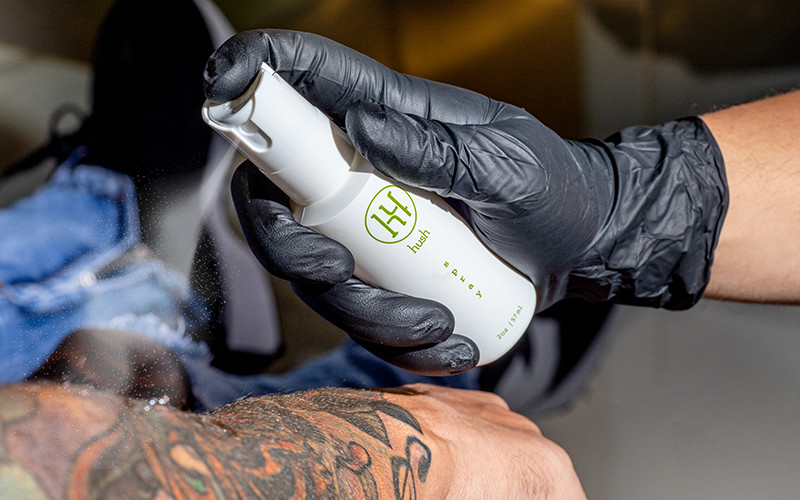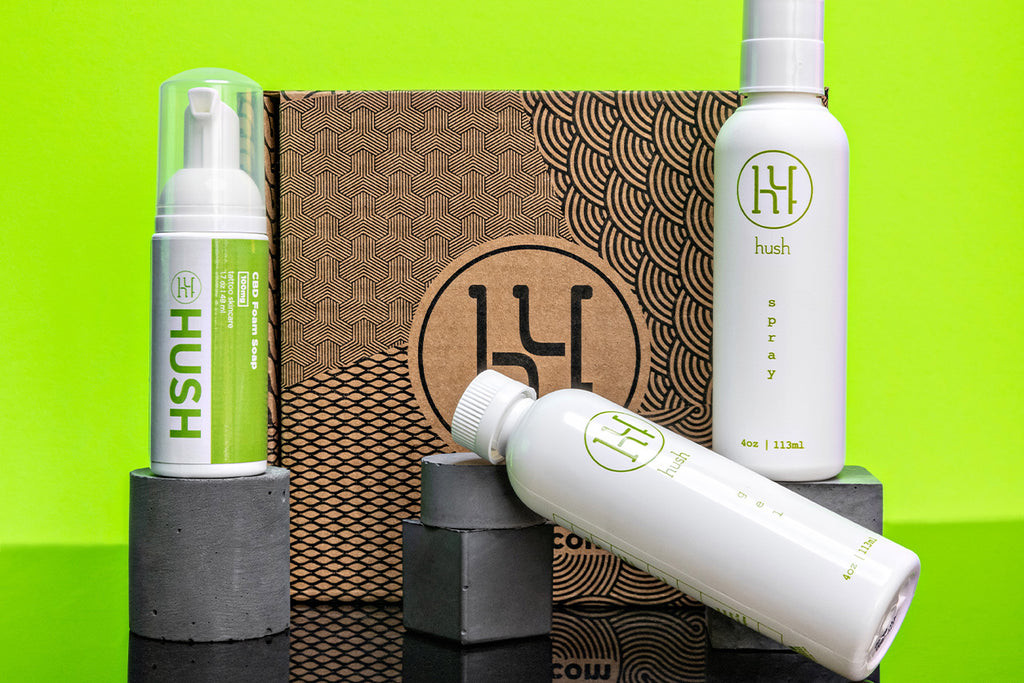Does Peeling A Tattoo Ruin It? No, tattoo peeling is a natural part of the healing process, and at tattooat.com, we’re here to guide you through it! The key is understanding what’s normal and what requires attention, ensuring your body art remains vibrant and healthy, and explore essential aftercare tips for maintaining your tattoo’s quality, and recognizing signs of infection or damage during the skin shedding process. Trust tattooat.com for expert advice and a smooth healing journey.
1. What Is Tattoo Peeling and Why Does It Happen?
Tattoo peeling is a standard part of the tattoo healing journey. As the epidermis sheds dead skin cells through exfoliation, revealing the fresh ink beneath, tattoo peeling doesn’t affect the tattooed area because tattoo ink resides in the dermis.
Usually, you’ll notice this peeling around the end of the first week after getting inked, after you’ve removed the bandage. During this time, your tattoo might appear dull, but don’t worry—this is simply due to dead skin cells sitting on top. After your tattoo peels, it’ll look vibrant and fresh once again. Sometimes, tattoo scabbing occurs during the second week of healing. While it might be tempting, avoid picking at these scabs and peeling skin.
2. Is Peeling a Tattoo Always Normal? Differentiating Between Normal and Abnormal Peeling
Peeling after getting a tattoo is a sign of skin regeneration, where old skin sheds to make way for the new. However, distinguishing between normal and abnormal peeling is very important.
Normal Tattoo Peeling
Normal peeling looks like light flaking, similar to what happens after a sunburn. Typically, it begins within a week after getting your tattoo and lasts for about a week. The flakes are thin, and you might notice tiny bits of color, which is just stained dead skin coming off.
 Normal Tattoo Peeling
Normal Tattoo Peeling
Abnormal Tattoo Peeling
Abnormal peeling is more intense, often accompanied by redness, swelling, or a feeling of heat. This could indicate an infection or an allergic reaction, especially if there’s pus, an unpleasant smell, or excessive pain. Bad peeling often involves thick scabs that seem to pull away from the tattoo. If something feels off, it’s best to consult your tattoo artist or a doctor. Early intervention can often prevent complications.
3. What Happens If I Peel My Tattoo? The Risks of Picking or Pulling Peeling Skin
It’s essential to resist the urge to peel your tattoo. Intentionally peeling your tattoo can lead to several complications that no tattoo artist wants to see.
Uneven Healing
Peeling off skin prematurely can remove ink, resulting in a patchy appearance with some areas lighter than others.
Increased Risk of Scarring
Picking at the skin can cause deep scabs to form. If these scabs are disturbed or too thick, they can lead to raised areas on your tattoo, permanently affecting its texture and appearance. Severe scarring might even prevent future touch-ups or cover-ups in the affected area.
Risk of Infection
During the healing phase, your tattoo is essentially an open wound. Peeling off skin before it’s ready increases the risk of bacteria entering, leading to infection. This can cause swelling, oozing, and intense pain, potentially ruining the tattoo.
Expensive Touch-Ups
Damaging your tattoo by peeling off skin might require touch-ups. While some artists offer free touch-ups for minor issues, improper aftercare isn’t usually covered.
4. How to Care for a Peeling Tattoo: Dos and Don’ts
Taking care of your tattoo during the peeling phase involves several key steps to protect and soothe the sensitive skin.
Washing Your Tattoo
Keeping your tattoo clean is essential to prevent infection during healing. Remember, getting a tattoo involves thousands of needle punctures, creating opportunities for infection. Washing your tattoo can also speed up the healing process.
Moisturizing Your Tattoo
Applying a high-quality tattoo aftercare cream or lotion is beneficial. It can relieve itching and support healing with the right vitamins and minerals. Products like HUSH tattoo care are formulated with healing and soothing ingredients and provide a protective barrier for proper healing.
 Hush Gel
Hush Gel
Soothing Your Tattoo
Itchiness is common during the peeling phase. Using products like Tattoo Numbing Spray can melt away discomfort. These formulas support the body’s natural infection-fighting system and provide relief.
Protecting Your Tattoo
Proper tattoo aftercare is essential for long-lasting results. Start by cleaning the area and using the right tattoo care products.
Protecting From the Sun
Protect your new tattoo from the sun, as sunburns can cause infection, disrupt the color, and necessitate touch-ups. Apply sunscreen and wear protective clothing when possible.
5. What to Avoid With a Peeling Tattoo: Key Precautions
Knowing what to avoid is just as important as knowing what to do when caring for a peeling tattoo. Here are some key precautions to keep in mind:
Don’t Panic
Peeling is a normal part of the healing process and will eventually stop. If you’re worried, contact your tattoo artist or dermatologist to ensure proper healing. Following aftercare instructions should lead to a smooth recovery.
Don’t Pick
Picking at your tattoo can cause additional trauma and remove ink. Let your tattoo heal naturally to retain maximum color and brightness.
Don’t Scratch
Scratching can damage the healing area and disturb the ink, causing patchy spots. Use products like HUSH Numbing Spray and CBD Healing Balm for relief without damaging your tattoo.
Don’t Wear Tight Clothes
Tight clothing can rub against the healing tattoo, causing irritation. Wear loose clothing to allow the tattoo to breathe and heal properly.
6. How Long Does Tattoo Peeling Last?
The tattoo healing process varies from person to person. Some may not experience peeling, while others may take up to a month to heal fully. Factors like body chemistry and the tattoo’s size and detail play a role.
Typically, peeling and scabbing start during the first week. Itchiness and scabs may also occur in the second week, but redness should fade by then. After this, itching and peeling should decrease significantly. Follow your tattoo artist’s aftercare instructions and contact them if you have concerns.
7. Is My Tattoo Peeling or Infected? Recognizing the Signs
It’s essential to differentiate between normal tattoo peeling and signs of infection. While reputable tattoo shops minimize infection risk with sterile equipment, allergic reactions or immune responses can still occur.
Symptoms of an Infected Tattoo
Infected tattoos look very different from simply peeling tattoos. While non-infected tattoos may have scabs, infected tattoos often have bumps with pus or larger nodules under the skin.
Redness and swelling are normal in the first day or two, but worsening or persistent redness and swelling can indicate infection. You may also experience pain and soreness.
Other symptoms include chills or fever. If you experience any of these symptoms, seek medical attention immediately.
8. How to Speed Up Tattoo Peeling: Effective Methods
While tattoo peeling is a natural process, some methods can help speed it up safely and effectively.
Regular Cleaning
Gently wash your tattoo with mild, fragrance-free soap to remove bacteria and dead skin cells. Cleansing products like HUSH CBD Foaming Soap can be particularly effective.
Consistent Moisturizing
Apply a thin layer of tattoo aftercare cream or lotion to keep the skin hydrated and prevent it from drying out and cracking.
Stay Hydrated
Drinking plenty of water helps keep your skin moisturized from the inside out, promoting faster healing and peeling.
Wear Loose Clothing
Allowing air to circulate around your tattoo can help speed up the peeling process. Wear loose, breathable clothing to minimize friction and irritation.
Avoid Sun Exposure
Protect your tattoo from direct sunlight, as sunburn can slow down healing and cause damage.
9. What to Do When Your Tattoo Starts Itching During Peeling
Itching is a common symptom during the tattoo peeling phase, but scratching can cause damage. Here are some ways to manage the itch:
Apply Tattoo Numbing Spray
Products like HUSH Tattoo Numbing Spray provide fast relief without damaging your fresh ink.
Use a Cold Compress
Applying a cold compress can help soothe the itch without causing harm.
Moisturize Regularly
Keeping your tattoo moisturized can prevent it from drying out and becoming more itchy.
Tap, Don’t Scratch
If you feel the urge to scratch, gently tap the area instead.
10. What Kind of Lotion Is Best for a Peeling Tattoo?
Choosing the right lotion is very important for a peeling tattoo. Look for lotions that are:
Fragrance-Free
Fragrances can irritate the skin and cause allergic reactions.
Hypoallergenic
Hypoallergenic lotions are less likely to cause irritation or allergic reactions.
Non-Comedogenic
Non-comedogenic lotions won’t clog pores, which can lead to infection.
Enriched with Vitamins
Lotions with vitamins like A, D, and E can promote healing and reduce inflammation.
Specifically Formulated for Tattoos
Tattoo aftercare products like HUSH CBD Healing Balm are specifically designed to support the healing process.
Address: 1825 SW Broadway, Portland, OR 97201, United States
Phone: +1 (503) 725-3000
Website: tattooat.com
FAQ: Tattoo Peeling
1. Is it normal for my tattoo to peel?
Yes, peeling is a normal part of the tattoo healing process, similar to how skin peels after a sunburn.
2. How much peeling is considered normal?
Normal peeling involves light flaking and shedding of thin skin layers, without excessive redness or swelling.
3. Can I peel off the skin from my tattoo?
No, it’s best to let the skin peel off naturally to avoid damaging the tattoo and risking infection.
4. What should I do if my tattoo is itchy while peeling?
Apply a tattoo numbing spray or a cold compress, and moisturize regularly to relieve itching.
5. How long does tattoo peeling usually last?
Tattoo peeling typically lasts about one to two weeks, depending on individual healing rates and tattoo size.
6. What are the signs of an infected tattoo versus normal peeling?
Signs of infection include excessive redness, swelling, pus, fever, and increased pain, while normal peeling involves light flaking and minimal discomfort.
7. Can I use any lotion on my peeling tattoo?
It’s best to use fragrance-free, hypoallergenic, and non-comedogenic lotions specifically designed for tattoo aftercare.
8. How often should I moisturize my tattoo during the peeling phase?
Moisturize your tattoo several times a day, or whenever it feels dry, to keep the skin hydrated.
9. What should I wear while my tattoo is peeling?
Wear loose, breathable clothing to minimize friction and irritation on the healing tattoo.
10. When should I contact my tattoo artist or doctor about peeling?
Contact your tattoo artist or doctor if you notice signs of infection, severe pain, or have concerns about the healing process.
Conclusion
 Tattoo Aftercare
Tattoo Aftercare
Peeling is a normal part of the tattoo healing process. At tattooat.com, we’re committed to making your aftercare easy and comfortable with products like our Numbing Spray, CBD Foam Soap, and CBD Balm.
Ready to explore stunning tattoo designs, connect with talented artists, and gain essential tattoo knowledge? Visit tattooat.com today and start your ink journey!
According to research from Portland State University’s Art Department, in July 2025, understanding the healing process of tattoos is crucial for maintaining the artwork’s integrity, and proper aftercare significantly reduces the risk of complications.